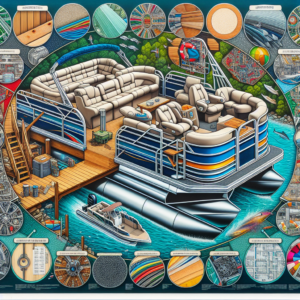Pontoon Boat Side Panels
Pontoon boats have become increasingly popular in recent years, and for good reason. They are versatile, spacious, and offer great stability while cruising the waters. Among the most critical features of pontoon boats are the side panels. These panels play a crucial role as they not only protect the occupants from the elements but also provide structural support to the boat.
Choosing the Right Pontoon Boat Side Panels
Pontoon boat side panels play a crucial role in the overall performance and functionality of your vessel. These panels serve as the outer skin of your pontoon boat and protect the occupants from external elements such as wind, rain, and sun. Choosing the right side panels for your pontoon boat involves considering different factors and options available from various manufacturers.
Materials Used in Pontoon Boat Side Panel Construction
One of the most important factors to consider when choosing side panels for your pontoon boat is the materials used in their construction. Common materials used for pontoon boat side panels include aluminum, steel, fiberglass, and acrylic.
Aluminum is a popular choice because of its durability, corrosion resistance, and lightweight. Steel is also durable, but it is heavier and more prone to rust than aluminum. Fiberglass panels are resistant to scratches and impacts, but they are relatively heavy and expensive. Acrylic or polycarbonate panels are lightweight, transparent, and affordable, but they are less durable and prone to scratches.
Features
| Material | Aluminum |
| Color | Black |
| Brand | RestorePontoon |
| Product Dimensions | 26"L x 480"W |
| Assembly Required | Yes |
| UPC | 710033422334 |
| Manufacturer | RestorePontoon |
| Number Of Pieces | 1 |
- Painted on both sides
- Sold in one continuous roll
- Easy to cut and wont bend easily
Factors to Consider When Selecting Side Panels
When selecting side panels for your pontoon boat, there are several factors to consider, including design, color, size, and shape. You also need to ensure that the side panels you choose are compatible with your boat’s deck and railing system.
If you intend to use your boat for fishing or other water activities, you may want to choose side panels with built-in fishing rod holders or cup holders. Also, consider whether you need any additional features such as doors, windows, or ventilation systems that can enhance the comfort and usability of your boat.
Comparing Different Brands and Manufacturers
There are many brands and manufacturers of pontoon boat side panels, and comparing them can help you find the best fit for your boat. Research the reputation and reviews of different manufacturers and brands to ensure you get quality side panels that meet your expectations and requirements. Consider factors such as price, warranty, customer support, and customization options when comparing different brands.
Customization Options for Personalization
Pontoon boat side panels can be customized to match your personal preferences and style. Manufacturers offer various customization options such as color, design, and graphics to help you personalize your boat’s appearance. You can also opt for custom-built side panels that fit your boat’s specific dimensions and shape.
By considering the materials used, factors to consider, different manufacturers, and customization options, you can find the right pontoon boat side panels that fit your needs.
Step-by-Step Installation Guide
Installing pontoon boat side panels might seem daunting, but with the right tools and materials, it can be a straightforward process. Here is an easy step-by-step guide to help you through the installation process:
Tools and Materials Needed for Installation
- Drill
- Screws
- Measuring Tape
- Scissors or Knife
- Marker or Pencil
- Side Panels
Pre-Installation Preparation
Before starting the installation process, ensure that you have all the necessary tools and materials required. Measure the length of each side panel to ensure that it is the correct size. Double-check the panels against the pontoon boat’s measurements to ensure a perfect fit.
Installation Process for Side Panels
- Place the side panels on a flat surface near the installation location.
- Mark a small line where you want the side panels to start and stop.
- Measure and mark where you want the panels to be screwed in place.
- Pre-drill the holes into the pontoon boat frame and side panels.
- Screw the side panels into position, starting at the top and working your way down to the bottom.
Troubleshooting Common Installation Issues
Some common issues that you may encounter when installing pontoon boat side panels include misaligned or ill-fitted panels, loose connections, and uneven surfaces. If you encounter any of these issues, make sure to double-check your measurements, pre-drill properly, and try again. If the issue persists, consider consulting a professional or contacting the manufacturer for assistance.
Installing pontoon boat side panels can be a fun DIY project, but if you’re not comfortable doing it yourself, don’t hesitate to reach out to a professional for help.
Maintaining Your Pontoon Boat Side Panels
Regular Maintenance Tips for Longevity
Regular maintenance of your pontoon boat side panels is crucial in ensuring their longevity. Here are some tips to keep your side panels in top condition:
- Wash your side panels regularly with soap and water to remove dirt and grime.
- If your side panels are made of vinyl, use a vinyl cleaner and conditioner to prevent cracking and fading.
- Inspect your side panels for any signs of damage, such as scratches, cracks, or holes, and have them repaired immediately.
- Apply a protective coating, such as wax, to your side panels to prevent damage from exposure to the sun and water.
Cleaning and Caring for Different Materials
Depending on the material your side panels are made of, they may require different cleaning and care. Here are some tips:
| Material | Cleaning and Care Tips |
|---|---|
| Aluminum | Wash with soap and water. Use a non-abrasive cleaner to remove stains. |
| Steel | Wash with soap and water. Use a rust remover to treat any spots of rust. |
| Vinyl | Use a vinyl cleaner and conditioner to prevent cracking and fading. |
| Fiberglass | Wash with soap and water. Use a fiberglass cleaner to remove stains. |
Repairing Damages and Scratches
Small scratches and damages to your side panels can be repaired with a DIY repair kit or by a professional. Here’s how to repair scratches and damages:
- Clean and dry the damaged area.
- If necessary, sand the damaged area lightly.
- Apply the repair material according to the instructions.
- Allow the repair material to dry completely.
- Sand the repaired area until smooth.
- Apply a protective coating, such as wax.
Seasonal Maintenance and Storage Advice
Proper storage of your pontoon boat and side panels during the offseason is essential in preventing damage. Here are some tips for seasonal maintenance and storage:
- Remove any debris or dirt from your side panels before storing them.
- Apply a protective coating, such as wax, to your side panels before storing them.
- Store your side panels in a clean, dry, and covered area.
- Inspect your side panels regularly during storage for any signs of damage or deterioration.
| Topic | Summary |
|---|---|
| Regular Maintenance | Wash with soap and water regularly, use vinyl cleaner if side panels are made of vinyl, inspect for damage, apply protective coating such as wax |
| Cleaning and Caring for Different Materials | Aluminum: wash with soap and water, use non-abrasive cleaner for stains. Steel: wash with soap and water, use rust remover for rust. Vinyl: use vinyl cleaner and conditioner. Fiberglass: wash with soap and water, use fiberglass cleaner for stains. |
| Repairing Damages and Scratches | Clean and dry the damaged area, sand if necessary, apply repair material, allow to dry completely, sand repaired area until smooth, apply protective coating such as wax |
| Seasonal Maintenance and Storage Advice | Remove debris and dirt, apply protective coating such as wax, store in clean, dry, covered area, inspect regularly for damage or deterioration |
Advanced Considerations and Enhancements
As you become more familiar with pontoon boats, you may start looking for advanced options to enhance your vessel’s appearance, performance, and comfort. Here are some considerations and enhancements to take your pontoon boat to the next level:
Upgrading to High-Performance Side Panels
If you’re looking for a significant performance boost, consider upgrading to high-performance side panels that offer reduced drag and increased speed. High-performance side panels are typically made of advanced materials like carbon fiber or Kevlar, which offer superior strength and durability. These panels are also lightweight, which reduces the overall weight of the boat and increases speed. However, keep in mind that high-performance side panels can be costly, and you’ll need to make sure they’re compatible with your boat’s design and functionality.
Adding Graphics and Wraps to Your Side Panels
Another way to enhance the appearance of your pontoon boat is by adding graphics and wraps to your side panels. Graphics and wraps are an excellent way to personalize your boat and make it stand out from the rest. You can choose from a wide variety of designs, colors, and finishes, including custom graphics that are tailored to your boat’s specifications. Wraps are also a popular option because they protect your side panels from scratches and sun damage while providing an eye-catching look.
Innovations and Future Trends in Side Panel Design
The marine industry is continually evolving, and new innovations and trends in side panel design are emerging. For example, some manufacturers are experimenting with new materials and processes like 3D printing and sustainable composites to create lighter, stronger, and more eco-friendly side panels. Others are exploring design solutions that improve aerodynamics, reduce noise, and enhance passenger comfort. Stay up-to-date with the latest developments to see what new options are available for your pontoon boat.
Accessibility Features and Compliance with Regulations
Finally, if you’re planning to use your pontoon boat for people with disabilities, you’ll need to consider accessibility features and compliance with regulations. Side panels with wheelchair-accessible gates or boarding ramps can make it easier for people with disabilities to board and disembark from the boat. You’ll also need to make sure your side panels meet all local and federal regulations, such as the Americans with Disabilities Act (ADA) guidelines and Coast Guard safety standards.
Frequently Asked Questions
- Q: Can I install new side panels by myself?
A: Yes, you can install new side panels by yourself if you have the necessary tools and knowledge. However, if you’re not confident in your skills, it’s always best to hire a professional to ensure proper installation.
- Q: How often should I maintain my side panels?
A: You should maintain your side panels regularly to ensure their longevity and prevent damage. It’s best to clean them after each use and inspect them for any signs of wear and tear. You should also perform seasonal maintenance and store them properly during the off-season.
- Q: What are some common issues with pontoon boat side panels?
A: Common issues with pontoon boat side panels include scratches, fading, cracking, and warping. These issues can be caused by exposure to sun, water, and other natural elements, as well as wear and tear from use. Regular maintenance and proper storage can prevent these issues from occurring.












